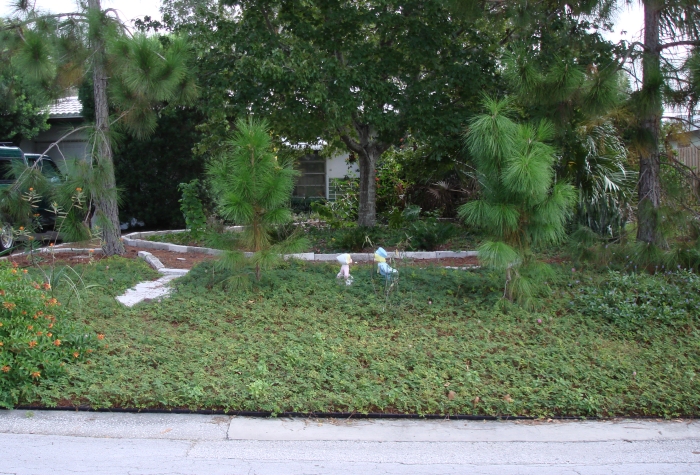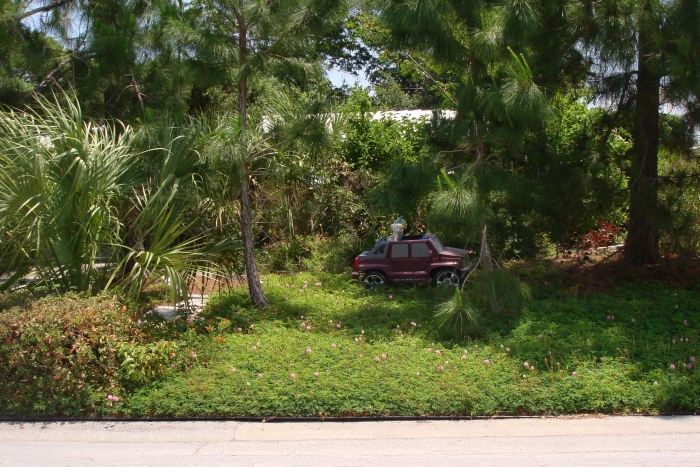|
||
 |
| Home |
| Who Is Stone Marmot? |
| Hear Our Music |
| Read Our Lyrics |
| Buy Our Music and Merchandise |
| News |
| Rants and Raves |
| Contact Us |
|
Permaculture and Native Plants, Part 2 By Bruce of Stone Marmot Sept. 30, 2013 Part 1 defined permaculture and discussed some of its goals and elements. Now we will see how permaculture can help with the design of our native landscapes. Permaculture originated from the observation of how natural ecosystems manage to take care of themselves without human effort. Using native plants that are appropriate for our area intuitively seems like the easiest path to a low maintenance landscape. But most of us find that we still spend a lot of time and effort maintaining our native yards. A big reason for this disconnect between intuition and actual experience is because we tend to choose and arrange our plants based on what we think will look pretty. We often ignore how the plants fit into and interact with their natural habitat. A common saying among us is “the right plant in the right place.” This guideline actually embodies a few of the core principles of permaculture. We need to apply the first permaculture principle discussed in Part 1, “Observe,” to understand where this plant naturally occurs and what the conditions are where the plant occurs. We also need to observe our own yards to see how well our conditions match those where the plant naturally occurs. We also need to consider the second permaculture principle, “Connect,” to understand how these plants interact with other plants. These plants don't usually occur alone in their native habitats, but in communities with other plant types. These different plant types often occur together because they have traits that mutually benefit each other. For example, many of the plants we use as groundcovers are pioneer plants, which are the first plants to move into a bare area. These pioneer plants thrive in poor soils. They also tend to improve these poor soils. Some add nitrogen to the soil. Others have deeper roots and pull and concentrate nutrients from deep within the soil towards the surface. Some attract pollinators and other beneficial critters. Others act as shelter plants, which may shade the soil from intense sun or act as windbreaks. But rarely does a single plant type perform all the functions necessary for a healthy ecosystem. That is why in natural landscapes we almost always see a mix of different plant types. So, rather than being frustrated because all these “weeds” keep appearing in our blanket flower patch, we should examine what function these “weeds” perform in nature. We can then replace these “weeds” with more desirable plants that perform the same function. Observing (that first permaculture principle again) what plants typically also appear in places where blanket flower naturally grows would give us an idea of what we need to have a healthy, and hopefully less weed-prone, landscape. A big problem with many yards, native or conventional, is that they ignore the ninth principle: “Collaborate with and encourage succession.” Ignoring this principle is a big reason for most of our “weed” problems. After all, a “weed” is any plant that is growing in a place where we don't want it. Rather than complaining and trying to eliminate these weeds, we should ask why they appear in the first place. In nature, landscapes mature. First, pioneer plants move into an area with poor, bare soil. Then some hardy shrubs will move in as the soil improves. Then some trees start growing. And as the soil and other conditions change, the original pioneer plants will die out and be replaced by other plants better suited for the new conditions. This is succession. But often we want our yards to be static. We expect them to look the same from year to year. This may be possible with little effort if our yards resemble a mature natural landscape, such as a forest. But many people feel the mature natural landscape look is too dark and crowded. Most people prefer a more open, sunny yard. The problem is that these open, sunny yards best resemble a natural landscape in the early stages of succession. Many of the plants used in these open yards are pioneer plants in nature. Consequently, the yard wants to grow up. Many plants appear that in nature would take this yard to the next stage in its natural succession sequence. These are often the “weeds” we keep fighting. The more open and bare an area, the more the “weed” problem. This is like trying to keep a cat perpetually in the kitten stage. The cat is going to grow up. So is your yard. In permaculture, we would not fight this tendency for our yards to “grow up.” Instead, we would aim for a desired mature state. We would then select plants for our yards that are either present in that mature landscape or on the natural path towards that mature state. We would then try to guide the changes that occur in our yards towards that desired mature state. We expect and welcome change in our yards. Of course, the least maintenance desired mature state is probably whatever your area was before the houses were built. Putting a bog into a place that was originally a pine flatwoods is probably not a good idea. Worse yet is simply choosing plants because they are pretty without considering that they would never occur together in nature. In permaculture, we want our yards to serve many of our needs. In the last article of this series we will discuss how native plants can be included in a food producing yard. Figure 1 - Residential landscape in early phase with the ground cover, sunshine mimosa, dominating. Figure 2 - Several years later palms, pines, coontie, and beautyberry overtaking the ground cover. The landscape is fuller than before despite losing a large maple tree due to a lightning strike. © 2003-2013 Stone Marmot Enterprises, all rights reserved. |
||

